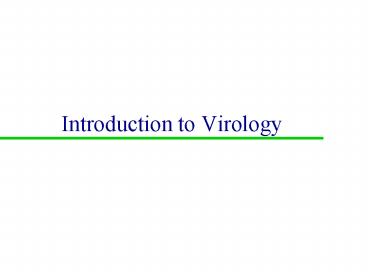Introduction to Virology - PowerPoint PPT Presentation
1 / 35
Title:
Introduction to Virology
Description:
Introduction to Virology. I. Objectives. What is a virus. How do viruses multiply ... Differences in multiplication due to differences in genome organization ... – PowerPoint PPT presentation
Number of Views:977
Avg rating:3.0/5.0
Title: Introduction to Virology
1
Introduction to Virology
2
I. Objectives
- What is a virus
- How do viruses multiply
- How are viruses classified
- (What are some of the diseases viruses cause)
3
II. Historical Perspective
- A. Ancient times
- 1. poliovirus
- 2. smallpox
- B. More recent history
- 1. 1790s
- Iwanowski
- 2. 1890s
- Jenner
4
III. What is a virus?
- A. Characteristics
5
B. Comparison to bacteria 1. overall
- Bacteria Virus
- Intracellular parasite (no) yes
- Plasma membrane yes no
- Binary fission yes
no - Filterable no
yes - Possess DNA RNA yes no
- ATP production yes no
- Ribosomes yes no
- Antibiotic sensitive yes no
6
- 2. Growth comparison
- 3. Size comparison
- 4. Genome size comparison
7
IV. Nucleocapsid morphology
8
- A. Helical
- B. Polyhedral
- C. Complex
9
V. How viruses multiply (13.10)
- 1. Basic strategy
- Attachment
- Penetration
- Synthesis of viral proteins and nucleic acids
- Maturation
- Release
10
2. Bacterial viruses Fig 13.12
- Lytic vs lysogenic cycle
11
3. General Animal Virus Multiplication
12
a.Virus Budding Fig 13.20
13
4. Differences in lab culture of viruses
- a. bacteriophage
- b. animal viruses
14
VI. Differences in multiplication due to
differences in genome organization
- A. Genome organization
15
B. DNA Viruses Life Cycle Fig 13.17
16
C. Replication of RNA viruses Fig 13.17
17
VI. Classification schemes
- A. Formal taxonomies
- B. Baltimore Classification
18
C. Nucleic acid type --gt Baltimore classification
- Class I
- ds DNA
- Class II
- ssDNA (positive and negative)
- Class III
- dsRNA
- Class IV
- ssRNA (positive)
19
- Class V
- ssRNA (negative)
- Class VI
- ssRNA (positive, replication intermediate DNA)
20
1. Class I dsDNA Viruses
- Bacterial
- Bacteriophage
- Plant
- Caulomoviridae
21
- Human
- Herpesviridae
- Adenoviridae
- Poxviridae
- Papovaviridae
- Papillomavirus
- Polyomavirus
- Vacuolating agent
22
- Hepadnaviridae
- After protein synthesis, DNA replicated through
RNA intermediate
23
2. Class II ssDNA viruses
- Bacteria
- Plant
- Animal
24
3. Class III dsRNA viruses
- Reoviridae
25
4. Class IV ss () RNA viruses
- Picornaviridae
- Togaviridae
- Flaviviridae
- Coronaviridae
- Calciviridae
26
5. Class V ss (-) RNA viruses
- Rhabdoviridae
- Filoviridae
- Paramyxoviridae
- Orthomyxoviridae
- Bunyaviridae
- Deltaviridae
- Arenaviridae
27
Retrovirus Life Cycle Fig 13.19
28
6. Class VI ss () viruses (dsDNA intermediate)
- Retroviridae
- Oncoviruses
- Lentivirus
29
D. Review of Replication Strategies
30
VII. Effects of Viral Infection on Cell
31
VIII. Oncogenic Viruses
32
IX. Plant viruses
- Morphologically similar to animal viruses
- Enter through wounds or parasites
- Some multiply in insects
33
X. Viroids
- Plant pathogens
- infectious naked RNA
- 20-25 identified so far
- ss covalent circle
34
XI. Prions
- A. Fig 13.21
- B. PrPC vs PrPSc
- Structural differences
- Detergent solubility differences
- Differences in susceptibility to protein
degrading enzymes
35
Prion diseases of humans and animals































